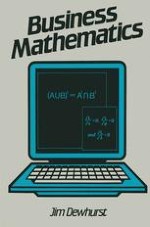1988 | OriginalPaper | Buchkapitel
Sets and Relations
verfasst von : Jim Dewhurst
Erschienen in: Business Mathematics
Verlag: Macmillan Education UK
Enthalten in: Professional Book Archive
Aktivieren Sie unsere intelligente Suche, um passende Fachinhalte oder Patente zu finden.
Wählen Sie Textabschnitte aus um mit Künstlicher Intelligenz passenden Patente zu finden. powered by
Markieren Sie Textabschnitte, um KI-gestützt weitere passende Inhalte zu finden. powered by
Any collection of objects is a set. The objects are called the elements or members of the set. It is normal to use upper case letters (i.e. capitals) to denote the sets and lower case letters for the elements of the sets. If an element p is a member of a set A, we write: <math display='block'> <mrow> <mi>p</mi><mo>∈</mo><mi>A</mi> </mrow> </math> $$ p \in A $$ and if p is not a member we write: <math display='block'> <mrow> <mi>p</mi><mo>∉</mo><mi>A</mi> </mrow> </math> $$ p \notin A $$ A set is completely determined or defined when all its members are specified. This is called the principle of extension. There are two ways in which a particular set can be defined. The first is by specifying its members: <math display='block'> <mrow> <mi>B</mi><mo>=</mo><mrow><mo>{</mo> <mrow> <mn>2</mn><mo>,</mo><mn>4</mn><mo>,</mo><mn>6</mn> </mrow> <mo>}</mo></mrow> </mrow> </math> $$ B = \left\{ {2,4,6} \right\} $$ Note that the members are enclosed in brackets and separated by commas. The second method is to state the property characterising the elements. We could therefore express this set B equivalently by writing: <math display='block'> <mrow> <mi>B</mi><mo>=</mo><mrow><mo>{</mo> <mrow> <mi>x</mi><mo>:</mo><mi>x</mi><mi>i</mi><mi>s</mi><mi>a</mi><mi>p</mi><mi>o</mi><mi>s</mi><mi>i</mi><mi>t</mi><mi>i</mi><mi>v</mi><mi>e</mi><mi>e</mi><mi>v</mi><mi>e</mi><mi>n</mi><mi>n</mi><mi>u</mi><mi>m</mi><mi>b</mi><mi>e</mi><mi>r</mi><mi>l</mi><mi>e</mi><mi>s</mi><mi>s</mi><mi>t</mi><mi>h</mi><mi>a</mi><mi>n</mi><mn>8</mn> </mrow> <mo>}</mo></mrow> </mrow> </math> $$ B = \left\{ {x:x\,is\,a\,positive\,even\,number\,less\,than\,8} \right\} $$ where the colon is to be read as ‘such that’.
